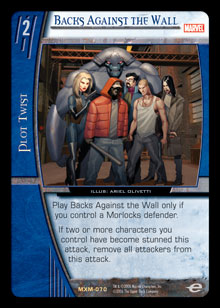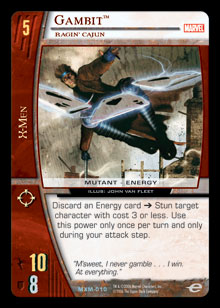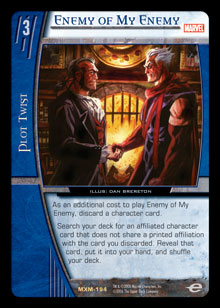
Not everyone who made Day 2 at Pro Circuit Atlanta was playing Squadron, X-Faces, or some sort of curve control deck featuring all the Mental goodies from The X-Men. A number of players excelled with decks that in today’s metagame strike us as foolhardy, original, and altogether rogue.
“Going rogue” has its advantages. By definition, rogue decks are not on anyone’s radar or an integral part of anyone’s testing gauntlet. At this point, X-Faces might as well have a big red “X” on its forehead; if you are serious about winning a Constructed Marvel Modern Age PCQ, you need to have a plan to beat the defining deck of the format. If my opponent plays an Archangel, Angel on turn 1, discarding a Melissa Gold ◊ Screaming Mimi to search out an X-Corp: Amsterdam, I (the prepared PCQ player) can be reasonably sure of ninety or ninety-five percent of the cards in my opponent’s deck. I know what to play around; I’ve playtested against X-Faces and understand how to win the matchup.
Now, if my opponent plays an Electric Eve on turn 1, evades, and drops a Tommy, I’m in a very different position. Instead of knowing all the cards in my opponent’s deck and patting myself on the back for playtesting against Morlocks evasion for ten excruciating hours, I’m calling over the judge and asking how Shrapnel Blast works. Vs. is a game of imperfect information; unlike Chess, where I know the exact position of every piece on the board, I can never be sure in Vs. System what cards my opponent has in his or her hand, resource row, or deck. Piloting a rogue deck to success requires an ability to take advantage of that uncertainty—to bait opponents into making mistakes or poor decisions because they have no idea what’s waiting for them when they declare Speed Demon, for example, into Storm, Leader of the Morlocks. One need look no further than X-Faces itself for evidence of the advantage to be gained by going rogue. Only twenty players brought X-Faces to PC: Atlanta, but almost all of them made Day 2. Their success transformed what was rogue in Atlanta into the most-played deck at $10K Austin.
So, without further ado, let’s take a closer look at a few creative alternatives to the dominant decks of the MMA metagame.
Jason Green
Characters
3 Artie
3 Electric Eve
4 Tommy
4 Leech
4 Tar Baby
2 Caliban
4 Healer
1 Toxin
4 Storm, Leader of the Morlocks
4 Marrow
1 Callisto
1 Scaleface
1 Ape
Plot Twists
4 Bum’s Rush
4 Retribution
4 Backs Against the Wall
4 Bloodhound
4 Mutant Massacre
4 Shrapnel Blast
 At PC: Atlanta, Green piloted M.E.A.T. (Morlock Evasion and Toxin) to a 7-3 record that was good enough for twenty-second place after Day 1. M.E.A.T.’s powerful plot twists rely on a board chock full of Morlocks, so the early turns of the game are spent amassing an army of small evaders. The need for a large number of characters in the later turns means that the early game is often spent evading in order to minimize the loss of little purple men. The Morlock player must strike a delicate balance between keeping enough guys on the table for cards like Backs Against the Wall, Retribution, and Shrapnel Blast to be effective; keeping the opponent’s own swarm from getting totally out of hand; and maintaining a high enough endurance for the late(r) game to actually happen.
At PC: Atlanta, Green piloted M.E.A.T. (Morlock Evasion and Toxin) to a 7-3 record that was good enough for twenty-second place after Day 1. M.E.A.T.’s powerful plot twists rely on a board chock full of Morlocks, so the early turns of the game are spent amassing an army of small evaders. The need for a large number of characters in the later turns means that the early game is often spent evading in order to minimize the loss of little purple men. The Morlock player must strike a delicate balance between keeping enough guys on the table for cards like Backs Against the Wall, Retribution, and Shrapnel Blast to be effective; keeping the opponent’s own swarm from getting totally out of hand; and maintaining a high enough endurance for the late(r) game to actually happen.
This, of course, is not to say that M.E.A.T. does not have an early game. Quite the opposite—the above list sports ten 1-drops, which is about as many as you’ll see in your average Squadron list. Tommy shines in the early game, allowing the M.E.A.T. player to recruit an extra character by evading a 1- or 2-drop during the recruit step.
M.E.A.T.’s greatest strength is its ability to minimize losses when the opponent possesses the initiative. Your opponent just stunned Healer with Shape? Evade Tar Baby before Lady Lark, Skylark forces you to choose between your 2- and 3-drops. Your opponent just flipped Other-Earth and attacked Marrow with Albert Gaines ◊ Nuke? Stun Artie and Leech to enable Backs Against the Wall and watch your opponent slump in his or her chair. Provided that you can satisfy the card’s requirement, plot twists don’t get much more powerful than Shrapnel Blast. A supercharged combination of It’s Clobberin’ Time! and Nasty Surprise, a well-timed Blast will often result in the opponent being on the wrong side of a one-way stun even if you do not control the initiative. Mutant Massacre complements the initiative-stealing aspect of the deck; if the M.E.A.T. player can stun back the opponent’s first attacker, he or she can exhaust another character to KO the opponent’s stunned guy before evading his or her remaining characters. This will usually result in an increase in board advantage for the M.E.A.T. player, even when on defense. Massacre is also great insofar as it can allow the M.E.A.T. player to disrupt X-Faces’ Beetle, Armorsmith / Yellowjacket engine by keeping the opponent from recruiting additional copies of the two excellent Masters of Evil searchers.
Efficient on the attack and proactive on defense, Green’s deck has a consistent curve, powerful plot twists, a great search card (Bloodhound), and perhaps most importantly, the element of surprise.
Jesse Hill
Characters
4 Electric Eve, Live Wire
4 Jubilee, Jubilation Lee
4 Shadowcat, Katya
4 Roulette, Hellion
4 Xorn, Shen Xorn
4 Bevatron, Hellion
4 Bishop, XSE Commando
4 Golden Archer, Wyatt McDonald
4 Firestar, Hellion
1 Gambit, Ragin’ Cajun
Plot Twists
4 Cryonic Grenade
3 Enemy of My Enemy
4 Feel the Burn
4 Insect Swarm
4 Phase Shift
4 The Evil Eye
 At PC: Atlanta, Jesse Hill piloted this homicidal, Energetic monstrosity to an 8-2 record good enough for sixth place after Day 1. Extraordinarily focused, Hill’s deck wants to reduce the opponent’s endurance total to 0 as quickly as possible. Xorn and Gambit, Ragin’ Cajun are the only characters in the deck that can’t throw burn directly at the opponent’s dome. Enemy of My Enemy is the lone non-offensive plot twist, and it’s only there to ensure that Hill has the characters he needs to incinerate his unfortunate opponent.
At PC: Atlanta, Jesse Hill piloted this homicidal, Energetic monstrosity to an 8-2 record good enough for sixth place after Day 1. Extraordinarily focused, Hill’s deck wants to reduce the opponent’s endurance total to 0 as quickly as possible. Xorn and Gambit, Ragin’ Cajun are the only characters in the deck that can’t throw burn directly at the opponent’s dome. Enemy of My Enemy is the lone non-offensive plot twist, and it’s only there to ensure that Hill has the characters he needs to incinerate his unfortunate opponent.
Like Green’s M.E.A.T. deck, burn’s strength lies in its ability to take huge chunks out of the opponent’s endurance total even when the opponent controls the initiative. For example, my opponent can attack into my 5-drop with a 4-drop and still end up taking 14 after I play The Evil Eye and use Firestar’s ability. If I have odds, I can exhaust Golden Archer to do 6 to my opponent on turn 4 after ditching my hand to Bevatron on turn 3. Burn’s focus on direct endurance loss can—if the opponent’s endurance is low enough—allow the deck to bypass traditional combat altogether.
Hill’s deck punishes mistakes; one misstep and the opponent will be so low on endurance that victory becomes academic. And it’s hard to play perfectly against a deck you’ve never seen before. I couldn’t have told you what Cryonic Grenade did on Day 1 of PC: Atlanta, but I’m betting most of Hill’s opponents could. After all, it helped beat eight of them.
Brian Raiff
Characters
4 Rick Jones, A Hero’s Best Friend
3 Beast, Furry Blue Scientist
4 Natasha Romanoff ◊ Black Widow, Super Spy
4 Dane Whitman ◊ Black Knight, Heroic Paladin
3 Amelia Voght, Acolyte
4 Black Panther, T'challa
3 Quicksilver, Mutant Avenger
3 Hawkeye, Clinton Barton
2 Anne-Marie Cortez, Acolyte
1 Doctor Druid, Anthony Druid
2 Amenhotep, Dark Pharaoh
1 Sabretooth, Savage Killer
1 She-Hulk, Gamma Bombshell
1 Sub-Mariner, Namor
3 Wonder Man, Simon Williams
1 Harry Delgado, Acolyte
2 Hercules, Son of Zeus
Plot Twists
4 Call Down the Lightning
3 Enemy of My Enemy
4 Flying Kick
4 Heroes in Reserve
Locations
3 Avengers Mansion
It’s hard to believe that only a month after PC: Atlanta, where Avengers / Brotherhood reservists made up about thirty percent of the field, we can call a deck like Brian Raiff’s “rogue.” Outgunned by Squadron, X-Faces, and Hellfire Club, reservists’ popularity experienced a massive drop-off after the PC; at $10K Austin two weeks later, only three people showed up packing Wonder Man, Simon Williams.
Of course, Brian Raiff probably didn’t feel like he was outgunned at PC: Atlanta. At the end of Day 1, he was heading into Day 2 sitting pretty in thirteenth place. Raiff’s deck takes full advantage of the free characters available to the reservist strategy. Four copies of Rick Jones, A Hero’s Best Friend and three copies of Amelia Voght that can be played free of charge allow the reservists to keep up with the blitzkrieg swarms of Squadron and X-Faces. It’s not hard to imagine the havoc a Natasha Romanoff ◊ Black Widow, Super Spy; Quicksilver, Mutant Avenger; and Rick Jones can wreak on an opposing board full of 1- and 2-drops.
 In the later turns, Enemy of My Enemy gives Raiff access to a variety of utility creatures. Playing against Hellfire Club? Recruit Anne-Marie Cortez, reveal another 4-drop, and suddenly Army of One is no longer a concern. Better yet, go find Sabretooth, Savage Killer and crack Sage, Tessa for infi. Don’t have the initiative on turn 5? Search out Amenhotep, Dark Pharaoh and kill your opponent on turn 6 with your extra character. Low on endurance? Trade in that Amenhotep for the perpetually invulnerable She-Hulk, Gamma Bombshell.
In the later turns, Enemy of My Enemy gives Raiff access to a variety of utility creatures. Playing against Hellfire Club? Recruit Anne-Marie Cortez, reveal another 4-drop, and suddenly Army of One is no longer a concern. Better yet, go find Sabretooth, Savage Killer and crack Sage, Tessa for infi. Don’t have the initiative on turn 5? Search out Amenhotep, Dark Pharaoh and kill your opponent on turn 6 with your extra character. Low on endurance? Trade in that Amenhotep for the perpetually invulnerable She-Hulk, Gamma Bombshell.
Solid plot twists back up Raiff’s versatile character core. Call Down the Lightning is basically an It’s Clobberin’ Time! that draws you a card (every card in Raiff’s deck is playable from the resource row). Heroes in Reserve and Avengers Mansion give the reservist player access to a steady stream of Nasty Surprises and Savage Beatdowns, allowing Raiff to attack up the curve on his initiative and assure stunbacks on his opponents.
Even still, reservists can have trouble with the explosive swarms of Squadron and X-Faces. With Hawkeye often not doing anything except allowing for massive breakthrough (Brave New World + Mob Mentality + Cannonball = Useless Hawkeye), the best reservist anti-swarm measure becomes a liability rather than a silver bullet. Our build of Avengers / Brotherhood reservists for PC: Atlanta ran Chrome and Senyaka to enable Unuscione, a 4-drop that could exhaust Speed Demon, Second Chance Speedster or Lady Lark when we didn’t have the initiative and put the hurt on Golden Archer without stunning when we did. A case can also be made for including System Failure in a reservist deck; the deck’s offensive plot twists are terrific but often unnecessary, even against the format’s control decks where revealing a 2-drop with Anne-Marie Cortez shuts off the two main defensive plot twists in the format (Duck and Cover and Shrink).
Largely written off as unviable for Marvel Modern Age, reservist decks nevertheless possess enough versatility that they can be shaped and tweaked to keep pace with the format’s top decks. Brian Raiff’s success attests to the power and potential of pairing Brotherhood with Avengers.
I have, up to this point, neglected what is perhaps the best reason for going rogue—fun. Nothing tops having your opponents ask to read the card that’s going to beat them. Any good game, Vs. included, rewards creativity with not only competitive success, but also with general, good old-fashioned enjoyment. If Insect Swarm can find a place in one of MMA’s top decks, then the possibilities for innovation, it would seem, must border on infinity.